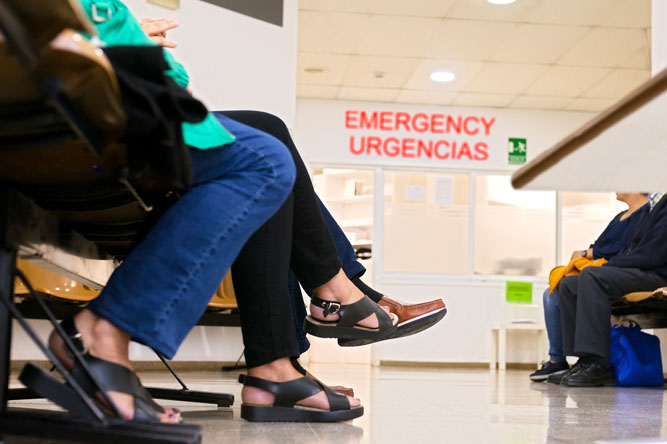
During the COVID-19 pandemic, the well-wish of “stay healthy,” or the question of “are you healthy?” often referred to the absence of COVID-19 infection. As we know, many who did not have COVID-19 were struggling with health issues from other diseases or illnesses, or from new or exacerbated symptoms of mental health—especially ones driven by isolation and fear.
As we emerge from the pandemic, those of us serving seniors—the demographic most impacted—return to serving our residents with a more holistic definition of health. We need to commit to making sure our programs encompass approaches beyond physical health. While many of our residents come to us with physical health concerns, there are non-physical factors we can address and improve on.
In addition to holistic health being the right thing for those we serve, we also have a responsibility as a key member of the healthcare continuum to improve both outcomes and expenses that are trending in the wrong direction. Research clearly shows that addressing health and quality of life (QOL) more holistically from birth to aging can improve outcomes and reduce costs.
Defining Health, Quality of Life, and Health Related Quality of Life (HRQOL)
Health has been defined for almost 75 years as being broader than physical health, including how we describe it in language, research, and policy:
- World Health Organization (in 1948) on Health: a state of complete physical, mental, and social well-being, not merely the absence of disease or infirmity.
- World Health Organization on Quality of Life: an individual’s perception of their position in life in the context of the culture and value systems in which they live and in relation to their goals, expectations, standards, and concerns.
- Merriam-Webster Definition of Health: the condition of being well or free from disease, 2. the overall condition of someone’s body or mind, 3. the condition or state of something.
- Merriam-Webster Definition of Quality of Life: overall enjoyment of life: general well-being…specifically: the degree to which a person or group is healthy, comfortable, and able to enjoy the activities of daily living.
- Centers for Disease Control and Prevention (CDC) on Health-related Quality of Life (HRQOL): an individual’s or a group’s perceived physical and mental health over time.
Health May Be Defined, but Has It Improved?
Using 2019 (pre-pandemic) data, it is clear to see that while health care expenses in the United States have increased, it has not driven a correlated increase in overall health.[1]
- Medicare spending grew 6.7% to $799.4 billion in 2019.
- Medicaid spending grew 2.9% to $613.5 billion in 2019.
- Hospital expenditures grew 6.2% to $1,192.0 billion in 2019.
- Physician and clinical services expenditures grew 4.6% to $772.1 billion in 2019.
- Prescription drug spending increased 5.7% to $369.7 billion in 2019.
- The U.S. spends more on health care as a share of the economy—nearly twice as much as the average Organization for Economic Co-operation and Development (OECD) country—yet has the lowest life expectancy and highest suicide rates among the 11 nations.
- The U.S. has the highest chronic disease burden and an obesity rate that is two times higher than the OECD average.
- Americans had fewer physician visits than peers in most countries, which may be related to a low supply of physicians in the U.S.
- Americans use some expensive technologies, such as MRIs, and specialized procedures, such as hip replacements, more often than our peers.
- The U.S. outperforms its peers in terms of preventive measures—it has the one of the highest rates of breast cancer screening among women ages 50 to 69 and the second-highest rate (after the U.K.) of flu vaccinations among people aged 65 and older.
- Compared to peer nations, the U.S. has among the highest number of hospitalizations from preventable causes and the highest rate of avoidable deaths.
Measuring Health
There have been several health measurement tools developed that bring both value for research and evidence for improvement—from very simple and real time to longer-term and more detailed analyses:
- CDC – Healthy Days Measure
- The World Health Organization Quality of Life (WHOQOL)
- Flanagan Quality of Life Scale
- The International Society for Quality of Life Research (ISOQOL)
One of the simpler methods is the CDC’s “Healthy Days Measure,” which provides a small sample of questions that can be summarized into three states of health: healthy day, unhealthy day (physical), and unhealthy day (mental).[2]
- Would you say that in general your health is excellent, very good, good, fair, or poor?
- Now, thinking about your physical health, which includes physical illness and injury, how many days during the past 30 days was your physical health not good?
- Now, thinking about your mental health, which includes stress, depression, and problems with emotions, how many days during the past 30 days was your mental health not good?
- During the past 30 days, approximately how many days did poor physical or mental health keep you from doing your usual activities, such as self-care, work, or recreation?
 Source: https://www.cdc.gov/hrqol/methods.htm
Source: https://www.cdc.gov/hrqol/methods.htm
The more complex The World Health Organization Quality of Life (WHOQOL) has six domains, with each having several metrics and broader overall quality of life and general health perceptions that can be measured over time with more specificity or by looking at bigger data sets.
- Domain I: Physical Capacity
- Domain II: Psychological
- Domain III: Level of Independence
- Domain IV: Social Relationships
- Domain V: Environment
- Domain VI: Spirituality/Religion/Personal Beliefs
- Overall quality of life and general health perceptions
Social Determinants of Health
Social determinants of health (SDOH) are defined as conditions in the places where people live, learn, work, and play that affect a wide range of health and quality of life risks and outcomes. SDOHs have a major impact on people’s health, well-being, and quality of life. Examples of SDOH, per the CDC and health.gov[3], include education access and quality, health care access and quality, neighborhood and built environment, and social and community context.
 Source: https://health.gov/healthypeople
Source: https://health.gov/healthypeople
Healthy People 2020 and Healthy People 2023
The specific goals set out by the CDC for the Healthy People 2020 initiatives[4] sadly culminated with a pandemic. Healthy People 2020 approached the measurement of health-related quality of life and well-being from a multidisciplinary perspective that encompassed three complementary and related domains, including self-rated physical and mental health, overall well-being, and participation in society.
Healthy People 2023 goals include the following goals:
- Attain healthy, thriving lives and well-being, free of preventable disease, disability, injury, and premature death.
- Eliminate health disparities, achieve health equity, and attain health literacy to improve the health and well-being of all.
- Create social, physical, and economic environments that promote attaining full potential for health and well-being for all.
- Promote healthy development, healthy behaviors, and well-being across all life stages.
- Engage leadership, key constituents, and the public across multiple sectors to take action and design policies that improve the health and well-being of all.
Dimensions of Wellness
Another framework related to senior services is the International Council on Active Aging® Dimensions of Wellness. Wellness is derived from our ability to understand, accept, and act upon our capacity to lead a purpose-filled and engaged life. In doing so, we can embrace our potential (physical, emotional, spiritual, intellectual, social, environmental, vocational) to pursue and optimize life’s possibilities. The wellness dimensions overlap and coordinate to provide rich environments for living. Wellness becomes a framework that is valuable for serving the wants and needs of a person engaged in life.
 Source: https://www.icaa.cc/activeagingandwellness/wellness.htm
Source: https://www.icaa.cc/activeagingandwellness/wellness.htm
2022 Focus on Quality of Life
In 2022, we challenge our peers in senior care to refresh our focus on health beyond the COVID-19 pandemic. Our focus over the last few years has been where it was most critical: infection control and saving our residents. As we move forward, we can make lives better through approaching our operations, systems, and programs from a holistic health and wellness approach that improves satisfaction, drives better outcomes, and helps us support the broader healthcare system.
As you evaluate these focus areas and programs, we look forward to hearing from you on your successes and challenges. We are ready to assist you wherever needed. We understand the challenges as operators in making this pivot, but we also know that as consultants we can support your vision and planning.
Contact Us
As a national leader in senior care and living management and consulting services, Health Dimensions Group is uniquely positioned to assist organizations with improving the holistic health of its residents. For more information, please contact us at info@hdgi1.com or 763.537.5700.
[1] CMS, https://www.cms.gov and The Commonwealth Fund, https://www.commonwealthfund.org/sites/default/files/2020-01/Tikkanen_US_hlt_care_global_perspective_2019_OECD_db_v2.pdf
[2] CDC and World Health Organization.
[3] https://www.cdc.gov/socialdeterminants/index.htm
https://health.gov/healthypeople/objectives-and-data/social-determinants-health












